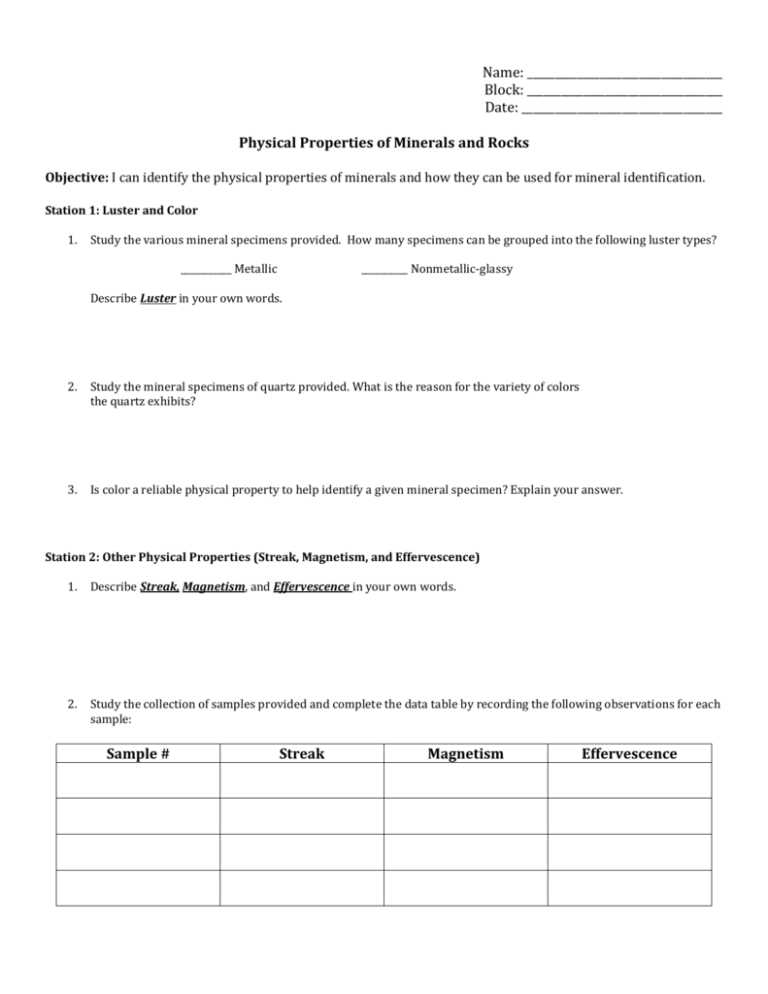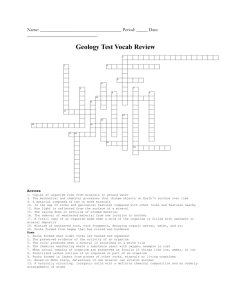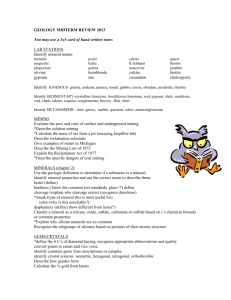File
advertisement

Name: ___________________________________ Block: ___________________________________ Date: ____________________________________ Physical Properties of Minerals and Rocks Objective: I can identify the physical properties of minerals and how they can be used for mineral identification. Station 1: Luster and Color 1. Study the various mineral specimens provided. How many specimens can be grouped into the following luster types? ___________ Metallic __________ Nonmetallic-glassy Describe Luster in your own words. 2. Study the mineral specimens of quartz provided. What is the reason for the variety of colors the quartz exhibits? 3. Is color a reliable physical property to help identify a given mineral specimen? Explain your answer. Station 2: Other Physical Properties (Streak, Magnetism, and Effervescence) 1. Describe Streak, Magnetism, and Effervescence in your own words. 2. Study the collection of samples provided and complete the data table by recording the following observations for each sample: Sample # Streak Magnetism Effervescence Station 3: Hardness The following hardness guide is useful to bracket the hardness of an unknown sample. Hardness Description Less than 2.5 Mineral can be scratched by fingernail. 2.5 to 3.5 Mineral cannot be scratched by a fingernail and cannot be scratch penny. 3.5 to 5.5 Mineral cannot scratch penny and cannot scratch glass. Greater than 5.5 Mineral can scratch glass. Determine the hardness for the small group of minerals provided and complete the data table. Sample # Hardness Which would tell you more about a mineral’s identity: luster or hardness? Why? _________________________________________________________________________________________________________________________________________________ Rock Identification A rock is a naturally occurring, solid mass of minerals or mineral-like matter. Geologists classify rocks into three major groups based on how the rocks form. Igneous rocks form when molten material – lava or magma – cools either on Earth’s surface or underground. Extrusive rocks form as lava cools quickly at or near the Earth’s surface. Extrusive rocks have either a finegrained texture or a glassy texture. Intrusive Rocks form as magma cools slowly farther beneath the earth’s surface. This slow rate of cooling allows mineral grains to grow large, and such a rock is said to have a coarse-grained texture. Sedimentary rocks form when pieces of rocks, minerals, or organic matter – all of which are called sediment-are compacted and cemented. Clastic rocks are sedimentary rocks that are made of fragments of weathered Earth materials. The fragments might be fairly large, such as pebbles; somewhat smaller, such as grains of sand; or very small, such as grains of clay. Chemical rocks are sedimentary rocks that form when minerals settle out of solution. Biochemical rocks are sedimentary rocks that form as the result of organic processes. Metamorphic rocks are rocks that form when existing rocks are subjected to changes in pressure or temperature. They can also form when they are subjected to chemical solutions. Metamorphic rocks may be foliated, which means that the components are arranged in parallel bands, or nonfoliated, which means that the rock’s components are not arranged in bands. 1. In your own words, describe what is meant by a rock’s texture. 2. What distinguishes the two main types of igneous rocks? Explain your answer. 3. Chalk is made of tiny fragments of marine organisms. To which group of rocks does chalk belong? 4. 4. Suppose you observe a rock with distinct bands. What type of rock might this be? Explain why.







